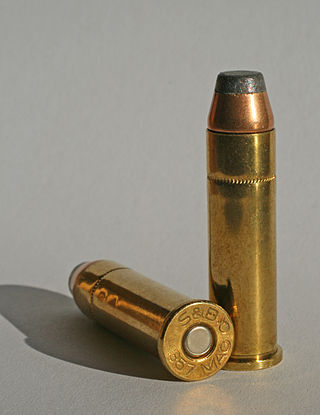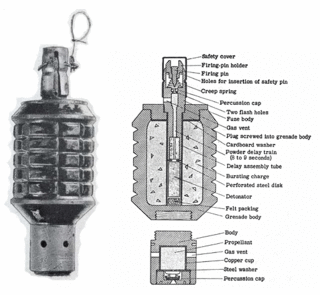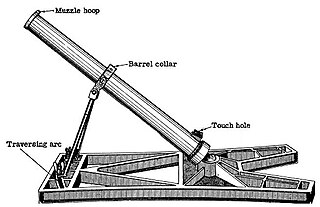Tubes and primers are used to ignite the propellant in projectile weapons.

A shell, in a military context, is a projectile whose payload contains an explosive, incendiary, or other chemical filling. Originally it was called a bombshell, but "shell" has come to be unambiguous in a military context. Modern usage sometimes includes large solid kinetic projectiles, which are more properly termed shot. Solid shot may contain a pyrotechnic compound if a tracer or spotting charge is used.

"Mills bomb" is the popular name for a series of British hand grenades which were designed by William Mills. They were the first modern fragmentation grenades used by the British Army and saw widespread use in the First and Second World Wars.

Stielhandgranate is the German term for "stick hand grenade" and generally refers to a prominent series of World War I and World War II-era German stick grenade designs, distinguished by their long wooden handles, pull cord arming and cylindrical warheads. The first models were introduced by the Imperial German Army during World War I and the final design was introduced during World War II by the German Wehrmacht.

A centerfire cartridge is a firearm metallic cartridge whose primer is located at the center of the base of its casing. Unlike rimfire cartridges, the centerfire primer is typically a separate component seated into a recessed cavity in the case head and is replaceable by reloading.

In an explosive, pyrotechnic device, or military munition, a fuse is the part of the device that initiates function. In common usage, the word fuse is used indiscriminately. However, when being specific, the term fuse describes a simple pyrotechnic initiating device, like the cord on a firecracker whereas the term fuze is used when referring to a more sophisticated ignition device incorporating mechanical and/or electronic components, such as a proximity fuze for an M107 artillery shell, magnetic or acoustic fuze on a sea mine, spring-loaded grenade fuze, pencil detonator, or anti-handling device.

Flash powder is a pyrotechnic composition, a mixture of oxidizer and metallic fuel, which burns quickly and produces a loud noise regardless of confinement. It is widely used in theatrical pyrotechnics and fireworks and was once used for flashes in photography.
The No. 76 special incendiary grenade also commonly known as the A.W. bomb and SIP grenade, was an incendiary grenade based on white phosphorus used during World War II.
This article explains terms used for the British Armed Forces' ordnance (weapons) and ammunition. The terms may have slightly different meanings in the military of other countries.

The Mk 2 grenade is a fragmentation-type anti-personnel hand grenade introduced by the U.S. armed forces in 1918. It was the standard issue anti-personnel grenade used during World War II, and also saw limited service in later conflicts, including the Korean War and Vietnam War. Replacing the failed Mk 1 grenade of 1917, it was standardized in 1920 as the Mk II, and redesignated the Mk 2 on April 2, 1945.
The military of the United States has used many different types of hand grenades since its foundation.

The Type 91 hand grenade was an improved version of the Type 10 fragmentation hand grenade/rifle grenade of the Imperial Japanese Army. Although superseded as a hand-thrown weapon by the Type 97 by the start of World War II it was still used by units in the Second Sino-Japanese War and by reserve forces, as well as the Japanese Navy's Special Naval Landing Forces.
A pyrotechnic composition is a substance or mixture of substances designed to produce an effect by heat, light, sound, gas/smoke or a combination of these, as a result of non-detonative self-sustaining exothermic chemical reactions. Pyrotechnic substances do not rely on oxygen from external sources to sustain the reaction.

The HG 85 is a round fragmentation hand grenade designed for the Swiss Armed Forces and still produced by RUAG Ammotec in Switzerland. HG 85 is the internal designation of the Swiss Army and replaces the HG 43 from WWII.

A grenade is an explosive weapon typically thrown by hand, but can also refer to a shell shot from the muzzle of a rifle or a grenade launcher. A modern hand grenade generally consists of an explosive charge ("filler"), a detonator mechanism, an internal striker to trigger the detonator, and a safety lever secured by a cotter pin. The user removes the safety pin before throwing, and once the grenade leaves the hand the safety lever gets released, allowing the striker to trigger a primer that ignites a fuze, which burns down to the detonator and explodes the main charge.
The No. 6 Grenade was a hand grenade used by the United Kingdom during World War I.

An artillery fuze or fuse is the type of munition fuze used with artillery munitions, typically projectiles fired by guns, howitzers and mortars. A fuze is a device that initiates an explosive function in a munition, most commonly causing it to detonate or release its contents, when its activation conditions are met. This action typically occurs a preset time after firing, or on physical contact with or detected proximity to the ground, a structure or other target. Fuze, a variant of fuse, is the official NATO spelling.

The Type 98 50 mm mortar was a Japanese smooth-bore, muzzle-loading weapon of the mid 20th century. The Type 98 designation was given to this weapon because it was accepted in the year 2598 of the Japanese calendar (1938) The Type 98 was used by Imperial Japanese Army engineers to destroy obstacles via a spigot bomb or bangalore torpedo.
The Frangible Grenade M1 was a specially designed factory produced molotov cocktail created by the United States in 1942 as it entered World War II (1939–1945). It was designed to provide lightly armed personnel with simple, uncomplicated weapons that were easy to mass-produce. It provided a cheap stopgap means of knocking out enemy vehicles, clearing out strongpoints, and harassing or killing enemy personnel until more effective weapons could be produced and distributed. It was dubbed "frangible" because it was made from glass, which is brittle and easily broken.

A friction primer is a device to initiate the firing of muzzle-loading cannon. Each friction primer consists of a copper tube filled with gunpowder. The tube fits into the cannon touch hole burying its lower end in the gunpowder chamber. The top end of the tube extending above the touch hole has a short perpendicular spur tube filled with a priming mixture of antimony sulfide and potassium chlorate. A roughened wire slider extends from the outer end of the spur tube through the priming mixture and the gunpowder tube. This slider wire is twisted into a loop on the opposite side of the gunpowder tube.













